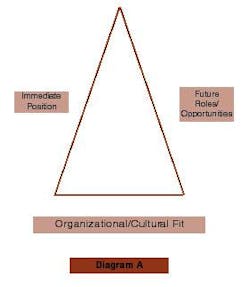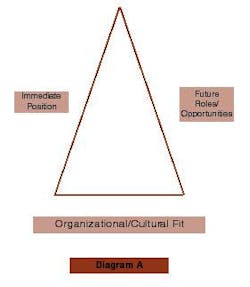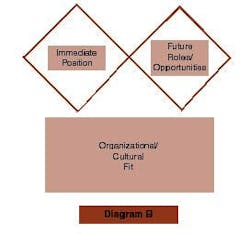The behavioral interview in dentistry
by Laurence H. Stone, DDS, MAGD, ABGD, and Scott Drinnan
The purpose of creating a behavioral interviewing program is to increase your knowledge of the desired behavioral characteristics of potential employees. This is made possible by formulating a defined and structured behavioral-interviewing process to help assess how potential candidates may fit within the culture of your practice.
Behavioral interviewing does not replace the need to evaluate the technical skills and qualifications of candidates. What it does is provide an additional dimension that expands what you can learn beyond traditional interviewing techniques.
The challenge
Having been in practice for more than 30 years, I knew it was inevitable that I would "outlive" some employees. But when I lost my entire staff last year within a period of six months, I quickly realized that my practice was facing a real crisis. Not having brought new staff members into the office in many years, I turned to the patterned interviews of the past and asked the usual, standard questions of prospective employees:
• What are your strengths and weaknesses?
• Tell me about your personal and professional goals for the next three years.
• What can you bring to this office?
After some admitted mistakes in hiring, I turned to a friend and patient, Scott Drinnan, who has over 20 years of experience in human-performance development. I quickly learned that my antiquated interviewing techniques were not serving me well. Hiring the wrong candidate for reasons that could have been discovered during the interviewing process does three things:
1) It leads to additional costs to rehire.
2) It results in loss of productivity.
3) It has a demoralizing effect within the office.
Context-setter
There are at least three broad areas of exploration during the overall interview process. There's the "technical, process, specific job skills" that are required to fulfill the immediate job. There's "industry knowledge and experience," which is related to the specific job skills, but is more indicative of roles the staff member might play in the future. The third area is the "interpersonal skills, abilities, and preferences," which is the area the behavioral interview focuses on.
Definition
What is the definition of behavioral interview? It is "a discipline which enables a hiring organization to gain insight and perspective about a candidate's interpersonal skills, abilities, and preferences, based on the exploration of real-life situations that the candidate has experienced in the past."
Hiring the right candidate is important for many reasons. Behavioral interviewing is one technique that is used to produce better results by providing more insight into a candidate's interpersonal skills, abilities, and preferences. These insights allow more informed decision- making, helping organizations to select the right individual, one who better matches the requirements of the immediate position, including roles this individual may play in the future in the organization's culture. (See Diagram A.)
In the first dimension, the "immediate position," we ask the question, "Is there a match between the candidate and the current need?" Unfortunately, in many cases, we tend to spend most of our energy and focus on this dimension. Sometimes, we'll think ahead to the second dimension, "future roles/opportunities," which asks the question, "How and where could the candidate play a different role in the future?" This anticipates the needs and desires of the candidate for professional growth and development, as well as the challenge to retain qualified candidates. In the third dimension, the "organizational/cultural fit," we want to know how well the candidate fits with the "chemistry" of the organization.
This is the area we tend to either minimize or take for granted, assuming we can figure this out through intuition. What tends to happen — in lieu of a structured behavioral interviewing program — is that we hire people like us, who may or may not serve the practice well. Or, we end up asking open-ended questions where candidates can generalize and provide answers that sound good and describe what we want to hear. Unfortunately, we discover deficiencies after they are hired, which has a negative impact on the success of the practice.
Impact
All three dimensions are important and require balance. Behavioral interviewing supports this by drawing a more complete picture of the candidate. Arguably, the cultural fit is the most important dimension of the three. Just as Pythagorus stated, "The square of the hypotenuse is equal to the sum of the squares of the two catheti in a right-angled triangle," we can draw a parallel in the context of hiring. My hypothesis is this: "In the world of hiring, the impact of the organizational/cultural fit is equally important to the sum of the impact of the other two dimensions combined." (See Diagram B below.)
Approach
Developing a behavioral interviewing program involves seven simple steps:
1) Develop a list of what behavioral characteristics you are looking for in a prospective employee. In a typical dental office, this might include such qualities as loyalty, stability, flexibility, being a team player, or being a self-starter.
2) Define each of these characteristics as they apply to your particular situation. For example:
Team Player: Makes explicit efforts to cooperate and encourage others to take part in joint efforts.
• Seeks and includes others' input
• Answers questions and shares expertise with others
• Shares credit for success and accomplishments with others
• Keeps others informed about progress of issues
3) Develop one or two questions for each characteristic that will elicit a person's preferences or likely behavior in a given situation.
For instance, in continuing with our example of the team player:
• Can you tell me about a situation where you had to coordinate your activities with three or more people?
• Can you tell me about a situation where you had to work with a group to get a job done?
4) Introduce the overall process.
Tell candidates that you'll be asking them to respond to questions about specific situations, and that you will want an overview of the situation, some key events, their role in these events, and the outcome of the situation. Advise them that you will be going back and asking more detailed questions — going through the situation "scene by scene" — and suggest that the candidate use a recent example, preferably within the last year or two. Explain that you will be using this information to gain a better perspective on who they are and how they might better fit in with the culture of your office.
5) Conduct the interview.
Ask one question at a time, requesting a specific example from candidates that will help describe their role in the particular situation. It's very important when you go back to ask detailed questions that you keep candidates anchored to a "point-in-time" before moving ahead to the next "scene" in the situation. As the candidates tell their stories, note observations of the desired, key behavioral characteristics. This includes positive confirmation that a candidate possesses the desired characteristic, as well as negative confirmation when candidates do not possess these characteristics. Most candidates will tend to generalize their storiess and provide a summarized view of how they handle situations. It is vital to stick to one particular situation to elicit the detail you want and go "one scene at a time."
6) Perform a post-interview analysis.
Immediately after the behavioral interview, analyze your observations and place each desired behavioral characteristic into one of the following categories:
Observed: Heard clear evidence of the behavior.
Not Observed: Either didn't ask a question that led to this characteristic or could not uncover specific examples.
Concerns: You heard evidence suggesting the candidate either might not possess or clearly does not possess the desired behavior.
7) Do a synthesis evaluation.
The outcomes from the behavioral interview need to be aggregated with the rest of the overall interview process. The interpersonal skills, abilities, and preferences that you observed from the behavioral interview need to be considered with the technical, process, specific job skills and the industry knowledge and experience to arrive at a fully-balanced decision. As mentioned earlier, the behavioral characteristics form one dimension that must be used within the context of the other two dimensions to make a better and more informed hiring decision.
Although there are few guarantees in life, behavioral interviewing provides a proven mechanism to obtain more insights into a potential candidate's interpersonal skills and preferences during the recruitment process. These insights help determine if there is a solid match between the candidate's innate abilities and the requirements of the immediate position and the roles they may play in the future and the organization's culture.
Behavioral interviewing also can help improve your ability to recruit the right candidates and advance your overall recruiting effectiveness.
Whether you are replacing an entire staff or just adding that one key employee, finding the right person for the culture in your office is critical to your success. It has been my experience that when properly done, the behavioral interview is highly accurate in predicting the behavior of potential new employees. It has now become an integral part of my hiring process, and I think you will find it to be an important tool in maximizing the potential for a successful hire in your office.


